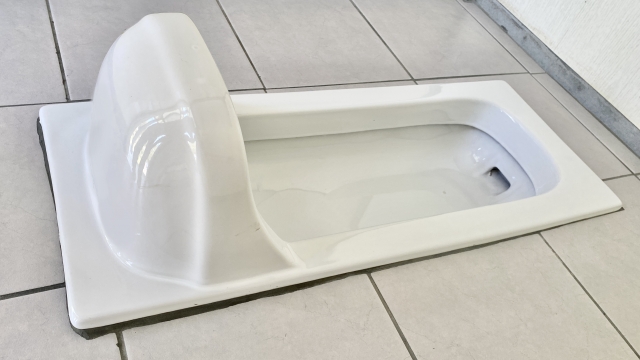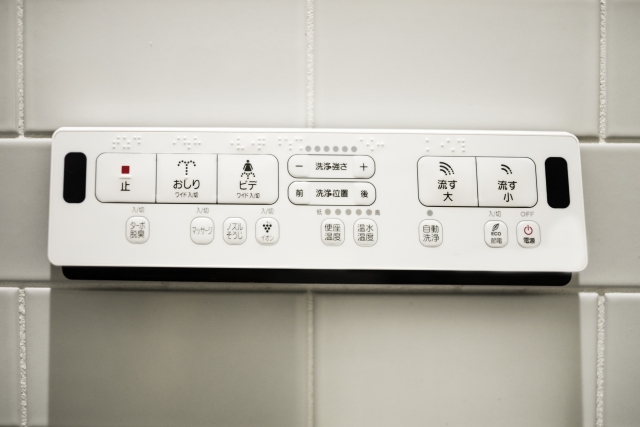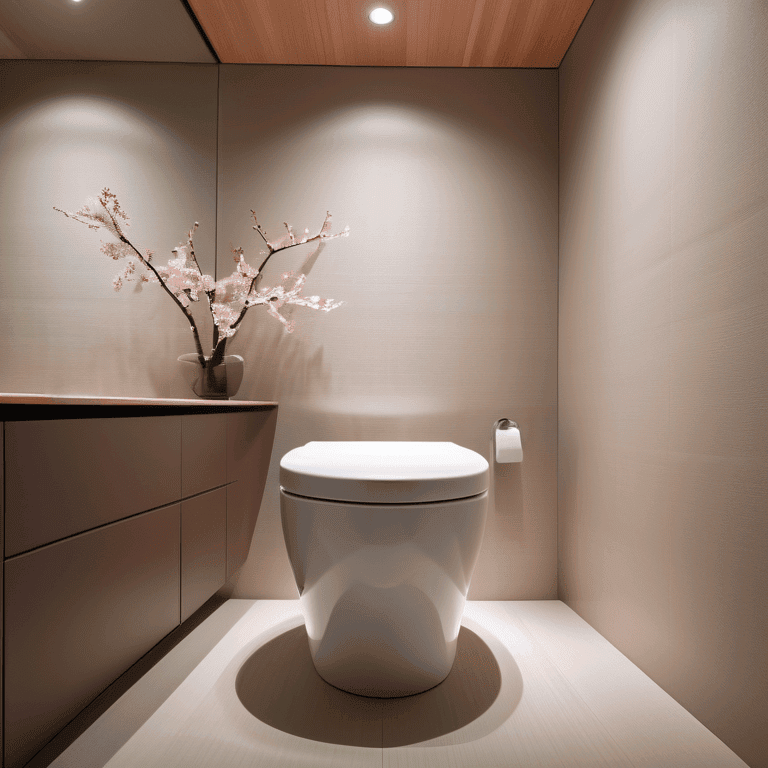Japan is a country known for its technological advancements, and this reputation extends even to its toilets, often referred to as washlets. These modern, high-tech Japanese toilets offer a comfortable, eco-friendly, and luxurious bathroom experience, turning what was once a daunting experience with traditional squat toilets to quality time spent on coveted home appliances that continues to be the topic of many a conversation.
You may have even seen intriguing public toilets in Japan that push the envelope further including the Pritzker Prize winning park toilets featuring transparent walls designed by Shigeru Ban that appear in Wim Wender’s movie Perfect Days. For those who haven’t seen the film or the toilets online yet, don’t worry the walls become opaque once the toilet is occupied so privacy is maintained.
Understanding the Technology Behind Japanese Toilets
To truly appreciate Japanese toilets, it’s important to understand the technology behind them. Bidet toilets, commonly known as washlets, are at the forefront of Japanese toilet technology. They offer a range of advanced features that enhance hygiene and comfort like remote control operations, sensor-based systems, and the highly popular seat warming function, setting them apart from conventional toilets and driving their global appeal.
The Engineering of Washlets
Washlets come equipped with remote control panels that allow users to adjust various settings, such as water temperature, pressure, and even seat temperature. The inclusion of sensors ensures a seamless experience, as the toilet can detect when the user is approaching or leaving and adjust functions accordingly. The control panel on the washlet also allows users to easily navigate through the different features and customise their toilet experience to their preference.
Innovations in Hygiene and Comfort
Japanese toilets have brought significant innovations in terms of hygiene and comfort. The inclusion of bidet functions eliminates the need for toilet paper and provides a more thorough and hygienic cleansing experience. The heated seats are often one of the most talked about as they offer extra comfort, especially during the colder months. Additionally, some smart toilets come with features like air drying, deodorisers, and even automatic cleaning systems. These innovations not only enhance the overall bathroom experience but also contribute to environmental sustainability by reducing the use of toilet paper and water consumption.
Types of Japanese Toilets
Japanese toilets come in different types, catering to various preferences and needs. Traditional Japanese squat toilets, known as washiki toire, involve squatting over a floor-level fixture. They are still found in some public toilets and older buildings. Western-style toilets, similar to those found in Western countries, have become more common in Japan. These toilets are equipped with a seat and flush system. Smart toilets, such as washlets, combine advanced features with the functionalities of traditional and Western-style toilets, offering a wide range of options for users.
Squat Toilets: Tradition Meets Function

Squat toilets, also known as Japanese-style toilets, have a long history in Japan and are rooted in tradition. These toilets require the user to squat over a floor-level fixture. While they may seem unfamiliar to foreigners, squat toilets have practical benefits, such as better alignment of the colon and a more natural position for bowel movements. They are still commonly found in public toilets, tourist destinations, and older buildings. Squat toilets reflect the cultural heritage of Japan and the importance of tradition in everyday life.
Western-Style Toilets: A Fusion of Cultures
Western-style toilets have become increasingly popular in Japan, reflecting the fusion of cultures and the influence of Western lifestyles. These toilets resemble those found in Western countries, with a seat and a flush system. They provide a familiar and comfortable experience for both locals and foreigners. The adoption of Western-style toilets in Japan signifies the country’s openness to embracing new ideas and incorporating them into everyday life. This fusion of cultures is evident in various aspects of Japanese society, including its toilets.
Smart Toilets: Features and Functions

Smart toilets, such as washlets, have gained widespread popularity in Japan and around the world due to their advanced features and convenience. These toilets offer a range of functions that enhance hygiene and comfort. Here is a detailed breakdown of the features and functions commonly found in smart toilets:
| Feature | Function |
| Bidet function | Provides warm water cleansing for improved hygiene |
| Heated seat | Offers comfort by heating the toilet seat |
| Air dryer | Dries the user after cleansing, eliminating the need for toilet paper |
| Deodoriser | Eliminates odors with built-in deodorising systems |
| Night light | Illuminates the toilet bowl during nighttime visits, providing visibility without the need for bright lights |
| Remote control | Allows users to control various functions and settings |
| Sensor-based system | Detects user presence and adjusts functions accordingly |
These smart features make using Japanese toilets a luxurious and personalised experience.
Where to buy Japanese Toilets in the UK?
The popularity of Japanese Toilets along with the growing Japanese expat community in London and the United Kingdom have made it possible to buy a wide range of Japanese toilets in the United Kingdom. Prices range from £300 to over £3000, and the Japanese style toilets you’ll find include wall toilets and luxury high-tech toilets, and come with features such as led lights that illuminate the bowl for easy visibilty during the night, a dryer function, and integrated bidet so you can save bathroom space without the need for a separate bidet.
If you’re looking for one of the most respected Japanese brands for toilets, Toto is a leading manufacturer and the original washlet creator with over 100 years history and available from dealers throughout the UK and Europe. You can also buy Japanese toilets from Victorian Plumbing which has excellent Trustpilot review and Washloo which is a British-based Japanese toilet brand.
How to Use a Japanese Toilet
While the advanced features of washlets may seem intimidating at first, operating them is relatively straightforward and it won’t take long to navigate a Japanese toilet with ease and confidence.
Operating a Washlet: A Step-by-Step Guide
Here’s a step-by-step guide to operating a washlet:
- Approach the toilet and familiarise yourself with the control panel or remote control.
- Adjust the seat temperature and position according to your preference using the remote control.
- Use the bidet function by selecting the appropriate water temperature and pressure.
- After using the bidet, activate the air-drying function and adjust the temperature as desired.
- To stop the operation of the washlet, press the stop button on the control panel or remote control.
- Exit the toilet and leave it clean for the next user.
Following these steps will ensure a comfortable and hygienic experience when using a washlet. The stop operation also allows you to maintain control over your experience at any time.
Environmental Impact
Japanese toilets also have a positive environmental impact, with a focus on water-saving technologies and sustainable practices. These initiatives aim to reduce water consumption and promote environmental sustainability. By incorporating features such as water-saving flush systems, automatic sensors, and energy-saving modes, Japanese toilets contribute to conserving water and reducing overall environmental impact. These environmentally conscious practices align with Japan’s commitment to sustainability and its efforts to address global environmental challenges.
Water-Saving Technologies
Water-saving technologies are a key feature of Japanese toilets. These toilets are designed to optimize water usage and reduce consumption. Some of the water-saving technologies incorporated in Japanese toilets include:
- Dual-flush systems that allow users to select a full or partial flush, depending on the waste being disposed of.
- Automatic sensors that detect when the toilet is being used and adjust the water flow accordingly.
- Low-flow flush mechanisms that use less water per flush without compromising on performance.
- Water-saving features that recycle and reuse water for various toilet functions.
By implementing these water-saving technologies, Japanese toilets contribute to water conservation efforts and promote sustainable practices in the bathroom.
Cultural Significance
Japanese toilets hold cultural significance in Japan, playing a role in Japanese etiquette and cleanliness practices. Japanese people value cleanliness and hygiene, and this extends to their approach to toilets – public toilets in Japan are known for their cleanliness, and toilet paper is always provided. The cultural emphasis on cleanliness and respect for shared spaces is evident in the meticulous maintenance of public toilets.
The Role of Toilets in Japanese Etiquette
Toilets in Japan are not just functional spaces but also reflect the cultural importance of etiquette and respect. Japanese etiquette emphasises cleanliness and consideration for others, even in private and public bathroom settings. It is customary to maintain cleanliness in shared toilets, and toilet paper is always provided for users. Visitors to Japan should be mindful of these cultural norms and ensure they follow proper toilet etiquette. This includes using toilet paper responsibly, avoiding littering, and leaving the toilet clean for the next person.
Public Toilets in Japan: A Model of Cleanliness
Public toilets in Japan are renowned for their cleanliness and hygienic standards. Whether in airports, train stations, parks, or other public spaces, Japanese public toilets are well-maintained and typically spotlessly clean. The meticulous cleaning and maintenance of these facilities reflect the importance placed on cleanliness and hygiene in Japanese society. This attention to cleanliness helps prevent the spread of germs and creates a more pleasant and comfortable experience for users. Visitors to Japan can expect to encounter clean and well-stocked public toilets and can see Japan’s commitment to providing a high standard of hygiene and comfort for all.
Sustainable Practices in Toilet Design
The design of Japanese toilets incorporates sustainable practices to minimize their environmental impact. These sustainable practices include:
- Efficient use of materials and resources during manufacturing and production.
- Use of eco-friendly and recyclable materials in toilet construction.
- Incorporation of energy-saving modes and features to reduce power consumption.
- Design elements that promote water conservation and reduce water waste.
- Integration of automated cleaning systems to minimize the use of cleaning chemicals.
By prioritising sustainability in toilet design, Japanese toilets contribute to a more environmentally friendly approach to sanitation and bathroom practices.
Conclusion
Japanese toilets showcase a captivating blend of tradition and innovation, reflecting the cultural nuances of Japan. From the evolution of basic sanitation to the sophistication of smart toilets, each design element serves a unique purpose. As sustainable practices and water-saving technologies become more prevalent, Japanese toilets continue to lead in environmental impact. Whether experiencing the comfort of a high-tech toilet or navigating the intricacies of public restroom etiquette, the world of Japanese toilets is more thank likely to stay a topic of conversations for years to come.
We hope that you found this article helpful to understand more about Japanese toilets whether you are traveling to Japan soon or searching for more information before buying one in the UK. In case you’re looking for more Japanese travels tips, please check our list of essential things to know before traveling.
Frequently Asked Questions
What Makes Japanese Toilets Different from Others?
Japanese toilets stand out from others due to their advanced features, such as bidet functions, heated seats, and remote control operation. They combine traditional Japanese style with innovative technology, providing a unique and luxurious bathroom experience.
Can Non-Japanese Easily Adapt to Using Japanese Toilets?
Non-Japanese people can easily adapt to using Japanese toilets with a little familiarity and understanding of the functions. While the advanced features may seem overwhelming at first, following basic toilet etiquette and reading these instructions will ensure a comfortable experience.
How Do You Maintain a Japanese Toilet?
Maintaining a Japanese toilet involves regular cleaning and proper usage. Cleaning the toilet regularly with mild cleaners or disinfectants is recommended. It’s also important to follow the manufacturer’s instructions for maintenance and to use the features responsibly to ensure proper hygiene.
Are Japanese Toilets Better for Health?
Japanese toilets, with their bidet functions and advanced hygiene features, offer improved cleanliness and hygiene compared to traditional toilets. The thorough washing and drying functions of bidet toilets can contribute to better personal hygiene and overall health.


